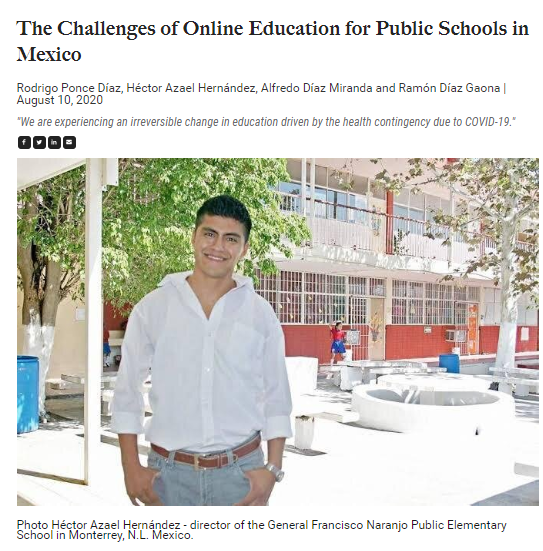Observatory: The Challenges of Online Education for Public Schools in Mexico
date:2020-08-16 18:14author:小编source:Observatoryviews:

Due to the advance of the contagion, the federal government proposes to start the next school year 2020-2021 with distance education, using television stations to bring educational content to all the homes in Mexico. With this proposal, it would seem that the next school year's challenge is solved; however, distance education presents many challenges to reach all the school-age population of children and young people.
How do three Mexican public schools face the health emergency for COVID-19?
1.General Francisco Naranjo Elementary School
How do three Mexican public schools face the health emergency for COVID-19?
1.General Francisco Naranjo Elementary School
Five years ago, the principal designed a weekly school day from the students' homes, using the EDMODO platform. When the contingency occurred, they continued to use the platform to meet each student's specific needs and the school in particular. It was in contrast to the generalized educational program used elsewhere throughout the state of Nuevo León. Each class and grade teacher had access to and follow-up to the activities, so the teacher implemented them and reviewed the students' areas of opportunity.
In this way, using the EDMODO platform and other communication channels such as WhatsApp and the Facebook page of the primary school, the school community continued the distance learning. It was able to complete the 2019-2020 school year.
2.Telesecundaria Emiliano Zapata Tele-Secondary School in Limón de la Luna, Mexico
In this way, using the EDMODO platform and other communication channels such as WhatsApp and the Facebook page of the primary school, the school community continued the distance learning. It was able to complete the 2019-2020 school year.
2.Telesecundaria Emiliano Zapata Tele-Secondary School in Limón de la Luna, Mexico
During this contingency, the principal, Alfredo and his teachers managed to continue their academic activities, mainly through using cell phones and the WhatsApp application. The teachers sent texts, videos, some audios, and photographs of pages with step-by-step solved exercises and explanations. The students returned their activities by the same means. On several occasions, there were delays in the return of assignments related to the lack of balance for the use of data on their cell phones. (Not all the students had home internet, and in the best of those cases, they share it with neighbors.)
In this situation, not all the students responded in the same way. Twenty percent of the students turned in all the homework, and another 20 % sent between 80 and 85 % of the activities. The rest of the students complied with 30-60 % of the tasks. One reason was the lack of access to Internet data. Another was the students' low interest, who took advantage of the contingency to work as day laborers. (Being a rural population, the confinement of quarantine was not total.)
3.Quintana Roo State Baccalaureate College, Rio Hondo Campus
In this situation, not all the students responded in the same way. Twenty percent of the students turned in all the homework, and another 20 % sent between 80 and 85 % of the activities. The rest of the students complied with 30-60 % of the tasks. One reason was the lack of access to Internet data. Another was the students' low interest, who took advantage of the contingency to work as day laborers. (Being a rural population, the confinement of quarantine was not total.)
3.Quintana Roo State Baccalaureate College, Rio Hondo Campus
Caught by the surprise suspension of the classes due to the COVID-19 contingency without an official platform where they could lecture on theory and related activities, the teachers shared the class activities on social networks. They accepted the delivery of completed assignments using any commonly used systems, such as Messenger, email, and even WhatsApp. This situation complicated the control of academic time and the formats for turning in activities; besides, the contact through social networks was awkward because students used pseudonyms for their names.
Interest in pursuing their studies at a higher level motivated some students to complete their online activities. However, some of the students trusted the rumor that there would be no failing grades, and so they did not turn in their activity assignments. It was an additional problem on top of the difficulty accessing the internet, as it is a rural community.
Source: https://observatory.tec.mx/edu-bits-2/the-challenges-of-online-education-in-public-schools-in-mexico
Interest in pursuing their studies at a higher level motivated some students to complete their online activities. However, some of the students trusted the rumor that there would be no failing grades, and so they did not turn in their activity assignments. It was an additional problem on top of the difficulty accessing the internet, as it is a rural community.
Source: https://observatory.tec.mx/edu-bits-2/the-challenges-of-online-education-in-public-schools-in-mexico

